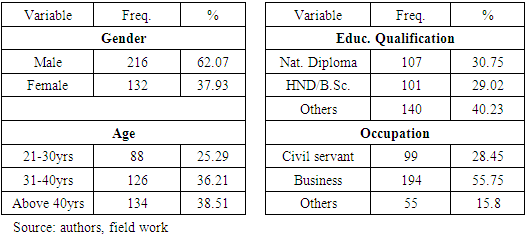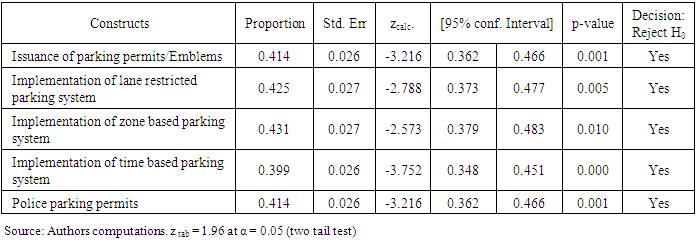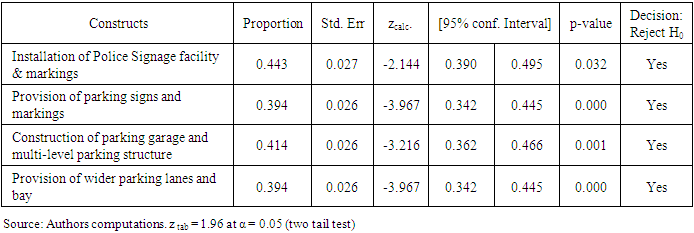-
Paper Information
- Paper Submission
-
Journal Information
- About This Journal
- Editorial Board
- Current Issue
- Archive
- Author Guidelines
- Contact Us
International Journal of Traffic and Transportation Engineering
p-ISSN: 2325-0062 e-ISSN: 2325-0070
2024; 13(1): 13-22
doi:10.5923/j.ijtte.20241301.03
Received: Jan. 3, 2024; Accepted: Jan. 21, 2024; Published: Jan. 23, 2024

Managing On-Street Parking in Central Business District in Owerri Municipality
C. C. Nwachi 1, D. E. Onwuegbuchunam 2, A. M. Mustapha 3, Q. C. Odoemela 1
1Department of Urban & Regional Planning, Federal University of Technology, Owerri, Nigeria
2Department of Maritime Technology & Logistics, Federal University of Technology, Owerri, Nigeria
3Department of Transport Management, Ibrahim Badamasi Babangida University Lapai, Niger State, Nigeria
Correspondence to: D. E. Onwuegbuchunam , Department of Maritime Technology & Logistics, Federal University of Technology, Owerri, Nigeria.
| Email: |  |
Copyright © 2024 The Author(s). Published by Scientific & Academic Publishing.
This work is licensed under the Creative Commons Attribution International License (CC BY).
http://creativecommons.org/licenses/by/4.0/

Management of on-street parking in Central Business Districts (CBDs) presents significant challenges to urban planners, transport administrators and other policy makers due to increasing urbanization, limited spaces for further development and growing vehicle ownership. The purpose of this study was to determine significant factors impacting on-street parking and management in Owerri Municipal’s CBD. This research employed a survey research approach to obtain primary data on characteristics of on-street parking and managerial challenges in the CBD. Accordingly, copies of structured, 5-point Likert scaled questionnaire were designed and administered to a random sample which comprised civil servants, business professional and other itinerant workers who operate in the CBD. The respondents were required to rate their response on statements relating to factors affecting on-street parking, parking infrastructure/facilities and their management in the study area. To test the hypotheses governing the study, a one-sample statistical test of proportions was applied to determine significant differences in opinion of the respondents. Evidence from the data analysis showed that on-street parking in the CBD stemmed from inadequate provision of parking facilities and infrastructure, illegal parks/parking and weak enforcement of regulations by the local authority. The authors also established from the analysis that issuance of paid parking permits, time, lane and zone controlled parking system were significant administrative measures for addressing on-street parking challenges in the CBD. In addition, implementation of approved parking signage, parking markings; parking spaces and provision of multi-story infrastructure were also found to be significant infrastructure solutions for managing the on-street parking in the study area. The implications of research findings on urban planning and policy formulation were discussed.
Keywords: On-street parking, Parking planning, Traffic congestion, Urban planning, Central Business District (CBD)
Cite this paper: C. C. Nwachi , D. E. Onwuegbuchunam , A. M. Mustapha , Q. C. Odoemela , Managing On-Street Parking in Central Business District in Owerri Municipality, International Journal of Traffic and Transportation Engineering, Vol. 13 No. 1, 2024, pp. 13-22. doi: 10.5923/j.ijtte.20241301.03.
Article Outline
1. Introduction
- The ever-growing population and economics around the world have pushed urbanization and development in the Central Business Districts (CBDs) forward at breakneck pace. The demand for neighborhood amenities for on-street parking near busy streets has increased due to the growth in population density. Parking on the street, whether parallel or perpendicular to the sidewalk or road, is known as on-street parking. It is more common in cities, and can be either metered or unmetered, subject to time limits or open for an infinite amount of time. Businesses in areas with on-street parking could experience congestion in foot and vehicular traffic which as a result put cyclists’ and pedestrians’ safety at risk. Furthermore, incessant on-street parking could possibly increase both air and traffic noise pollution when vehicles idle or move around looking for parking spots. In urban mobility, parking facilities have always played a crucial role in making city centers easily accessible. Parking has been a trending issue which has bothered urban planners and transport experts in the recent years. Parking is one of the major issues in today’s world that has arisen due to the increase in road traffic [1]. The unavailability of parking spaces has significantly increased the need for parking spaces especially in Central Business Districts. Poorly managed on-street parking is generally viewed as a cause of congestion and the only widely used law is a parking ban on arterial streets [2].However, On-street parking management influences the manner, location, timing and duration of parking along streets to ensure that such parking is done efficiently and is consistent with wider goals for the street, the area, and the transport system. Specific objectives include rationing available spaces, establishing orderly and efficient streets, and preventing negative impacts on traffic, public transport and people on foot or bicycles. On street parking management goals are pursued using a wide range of tools, including marking where parking is allowed and prohibited, designing parking spaces and associated facilities and signs, limiting access to certain groups, setting time limits, charging fees, enforcing compliance with all of these arrangements and monitoring success. Effectively managed on-street parking can improve efficiency of use of limited urban space, increase pedestrian safety by lowering vehicle speed, support local businesses and reduce driving time [3].Many cities have recently recognized the need for parking rules. In the hopes of regulating parking on city streets, decreasing traffic jams by shortening parking sessions, and boosting traffic flow, Ghana implemented a paid parking plan since June 2006 [4]. Similarly, in restricting on-street parking, various technologies are employed in parking management. In Chicago, city officials recently leased the city’s metered parking spaces to private investors for a term of 75 years to attract capital to upgrade the existing parking system. In San Francisco, local agencies are working to build a system using real-time parking data to manage congested streets and relieve a parking shortage [5]. There is considerable technology available for managing on street parking, including mobile phones, ticket machines, camera enforcement, information technology for record keeping systems, etc. but in most cities in low income countries, manual collection systems are used [6]. These strategies are not novel, but little emphasis has been paid to how they might be used and integrated to achieve larger transport, economic, environmental, and related goals [7].Many streets in Nigerian cities are too narrow for pedestrians and there are often no designated pedestrian walkways. Congestion is even worse by double vehicular parking along these narrow streets. Challenges to effective on-street parking management include, for example, rampant illegal parking, see [8]; [9]; [10]; lack of proper marking and signage, lack of coordination among agencies [11], lack of political support [10], and weak enforcement of regulations [12]. In Owerri, the capital city of Imo state, Nigeria, on-street parking has posed a significant challenge in the Central Business District (CBD) interlinked by Douglas, Wetheral and Bank roads, etc. This scenario has been exacerbated by the increase in urbanization, population growth and lack of adequate parking facilities. In almost all major cities, the time and frustration associated with finding a parking facilities during peak-hours not only upsets drivers, but also significantly decreases the city’s economic, environmental, and social sustainability due to the resulting traffic congestion, which in turn causes delays in travel time and increases the cost of traveling due to the increased automobile fuel consumption in the process of accomplishing a delayed journey. Although the government of Imo State has made effort to regulate on-street parking; this includes the creation of enforcement units to tackle illegal parking. However, the management of on-street parking remains a serious difficulty due to limited parking spaces in the CBD and lack of adequate enforcement measures employed expressly to regulate on street parking. Much of enforcement of regulation is centered on vehicular traffic flow thus neglecting remote factors contributing to traffic problem within the CBD. This has resulted to overcrowding, traffic congestion, and safety hazards. The urban planning problems arising from on street parking and associated traffic congestion, economic losses and blight in urban planning landscape have provided the context and impetus to this paper. This research aims to determine significant strategies for managing on-street parking in Owerri CBD, considering the specific challenges and limitations faced in the city. Objectives of the studyi. To determine the significant factors affecting on-street parking in Owerri Central Business District.ii. To evaluate significant administrative strategies for managing on-street parking in the CBD.iii. To determine the significant parking infrastructure facilities required for managing on-street parking in Owerri CBD.
2. Conceptual Framework
2.1. Parking Planning and Enforcement
- Parking planning is crucial to effective operation of transportation system. Transit vehicles, motorists etc. in transit must eventually park at some point within the transport network. If parking is not well provided for, it can disrupt traffic flow and cause congestion. Parking bottle-neck often encountered is parking on the side of the road. The ability to provide and operate effective on-street parking management helps in reducing traffic congestion, optimizing space utilization, and enhancing the city's mobility and overall liveability [13]; [14]. Park planning process enables urban planners for instance to carry out inventory analysis of existing parking facilities and infrastructure, determine space requirements and ensure optimal allocation of parking spaces. Effective on-street parking management requires the implementation of strategies such as parking pricing, time limits, and parking technology, which ensure the efficient utilization of available parking spaces [15]. Growing urbanization, automobile ownership has led to growing demand for parking and limited availability of parking spaces. Enforcement of requisite regulations is an integral part of management of on-street parking. Thus, sparking rules enforcement is needed to optimize spaces available and prevent illegal parking.
2.2. Theoretical Review
2.2.1. Theory of Demand/Supply
- The Demand and Supply Theory (DST) provides a suitable framework for understanding and managing on-street parking in CBDs, see [16]. Thus, DST as the theory underpinning consumer demand behaviour, supports that increasing the supply of parking spaces/facilities, and application of pricing mechanisms could be used to regulate the demand for parking facilities. Specifically, pricing can be used to limit demand in space limited CBDs. This approach ensures efficient allocation of resources and sustainability in managing parking system. Buchanan & Hatzopoulou [17] however posit that smart parking technologies could be applied to optimize parking space allocations and free up more spaces to satisfy demand. This would also guarantee efficient pricing. The DST application could also engender price sensitive park users to seek alternative transportation modes to access CBDs. This way, demand for parking spaces can be reduced, and the price of parking can be lowered. This approach has the added benefit of reducing traffic congestion, improving air quality, and promoting healthy and active lifestyles. Thus, market based approach as supported by DST has been shown to be effective in reducing congestion and improving the utilization of parking spaces.
2.2.2. Theory of Sustainable Urban Mobility
- According to Dimitriou, & Gakenheimer [18], sustainable urban mobility theory supports the design and management of urban transport systems in such a way as to meet the following criteria;• Accessibility: Transportation systems should be designed to provide access to goods, services and opportunities for all users, regardless of their income, age, or physical abilities.• Sustainability: Transportation systems should be designed to minimize the negative environmental impacts of transportation, including air pollution, greenhouse gas emissions, and resource consumption.• Equity: Transportation systems should be designed to promote social equity and inclusion by ensuring that all users have equal access to transportation services and facilities.• Safety: Transportation systems should be designed to prioritize the safety of all users, including pedestrians, cyclists, and drivers.Therefore in managing challenges associated with on-street parking in CBDs, care should be taken to ensure inclusivity of all users and stakeholders, reduce externalities like air, visual & noise pollution and excessive resource consumption.
2.3. Empirical Review
- Several studies have examined the characteristics of on-street parking with a view to addressing on-street parking challenges. For example, Peprah et al., [4] investigated the attitude and reason behind the On-street parking behavior displayed along Offinso road in Kumasi. The authors established that improper parking of vehicles along the road reduces the capacity of the road and can cause accident. Similarly, Baig, Sahito, & Arsla-Bano [19] found that increasing number of vehicles on street, encroachment; inadequate parking space and poor road condition are the main causes of traffic congestion in Pakistan. Two strands of opinion stand out in the literature. Some studies recommended pricing and time limited space allocation as part of management strategy to moderate demand for on-street parking. Notable papers include: Chullabodhi, Chalermpong, & Ratanawaraha [20] which examined the root causes of ineffective on-street parking management stemming from misalignment of government policy objectives, a fragmented institutional framework, lack of interest and commitment from both national and local policymakers, the limited legislative authority of the local government, lack of on-street parking policy, lack of planning and review, ineffective law and regulation enforcement, lack of monitoring mechanisms, and low perceived seriousness of parking infringements. Findings recommended integration of robust on-street parking policy in urban and transport planning framework. The paper by Pucher and Renne [21], analyzed the impact of various parking management strategies, including time limits, pricing, and technology-based solutions, on parking availability and vehicle usage patterns. They posit that implementation of time-limited parking and pricing policies had a significant impact on reducing parking demand and increasing turnover rates. Zhu and Li [22] analyzed the impact of parking supply, pricing, and technology-based solutions on parking demand and vehicle usage patterns. Empirical findings support that the combination of on-street and off-street parking supply, dynamic pricing, and technology-based solutions such as mobile parking applications and in-vehicle parking sensors had a significant impact on reducing parking demand and increasing turnover rates. Similarly Pandey et al., [1] examined on-street parking demands in the Indian CBD and recommended market based solution- the need of hourly fine as the most optimized measure that can be implemented to overcome the current parking scenario. Bhure, Bache, Bedmutha, Pawar, Shrivat & Motegaonkar, [23] examined parking characteristics such as the use of the parking place, use of parking spaces on the street, residence time, total number of vehicles in one area during the measurement, localization of parking capacity and relevance of the parking category for better efficiency of road traffic. The study finds that sustainable transport scenario; the pricing strategy i.e. parking pricing is a key counter-measure towards reducing on-street parking. Other papers support provision of infrastructure to address on-street parking challenges. Al-Jameel, & Muzhar, [24] examined the characteristics of on-street parking in Al-Najaf city urban streets. The study evaluated the average turnover, waiting time and type of parking and found that illegal parking behavior is common both on weekdays and weekend especially during the peak period. It therefore recommended provision of specific lots for parking vehicle and also to build and regulate off-street parking facilities in order to reduce the demand for on-street parking. Pahari, Khanal, & Khanal, [25] examined on-street parking index such as street length, width of the parking space, number of vehicles and parking accumulation in kathmandu metropolitan city. They find that long term alternatives like multi-storey parking lots are required rather than allocating parking area on the already narrow streets. Alhodairi [26] examined the effects of on-street car parking on travel behavior in Sebha, Libya. The study revealed that on-street car parking is mainly angled and do not follow any kind of order hence affecting the traffic lanes by narrowing their widths, especially during the peak hours. Study findings support that redesigning of available space to provide proper parking, applying strict traffic rules and regulations, and promoting the use of off-street parking areas would mitigate on-street parking. Other authors however, assert that pure administrative strategy could be employed to optimize use of existing facilities. Notable papers include: Musa, A., Musa, I., Labaran, Rabilu & Farouk, [27] which carried out forecasting on monthly income generated by an off-street parking facility located at Kano central Eid-ground. The study recommended use of market based pricing system to control on-street parking. Haider et al., [8] examined on-street parking scenarios such as cause & effect and management of on-street parking in Bangladesh. Findings showed that a structural policy should be formulated by the city authorities to overcome on-street parking. Romadhona, & Ikhsan [28] analyzed the performance of road segment, U-turn, and solutions of on-street parking effects. The study revealed that parking ban on the road body can improve the performance of the road. Wednesday, Said, Nurlaily, Tri, & Sumiyattinah, [29] focused on the condition of parking in the form of available parking spaces, and the parking characteristics of vehicle owners, as well as the magnitude of side friction due to on-street parking. The study revealed the necessity to divert parking lot from the road (On-street parking) to the parking lot (Off-street parking) especially during peak hour in order to reduce the level of on-street parking. This recommendation is consistent with Smart parking for Smart cities in some countries but merits some examination.The impact of Smart parking has been dealt with by some authors. For example, Wiseman [30] explored the benefits of remote self-parking of autonomous vehicles in many metropolitan areas in Israel. Findings revealed that remote self-parking can be of great advantage as vehicles will park strictly in the right position with almost no unused space and the parking slots will be signified according to the vehicle type. Similarly, Zhang, W., Guhathakurta, Fang, & Zhang, G. [31] estimated the potential impact of Shared Autonomous Vehicles system (SAVs) on urban parking demand. The simulation results showed that SAVs can eliminate up to 90% of parking demand for clients who adopt the system. In addition, Stein [32] examined the impact of autonomous vehicle revolution on urban land use patterns. The study revealed automobiles will drop passengers off and then drive themselves to remote parking areas, thus, reducing the need for downtown parking. Tang, Yu, Feng, & Mei, [33] assessed the potential impacts of autonomous vehicles (AVs) on urban parking. The results revealed that autonomous vehicles (AVs) could decrease the total parking cost and increase parking convenience for both AVs and human-driven vehicles (HDVs).In all the papers reviewed, there appears to be lack of consensus among the authors on the best practice strategy for addressing on street parking in CBDs. So far, the authors seem to agree on study location specific solutions to on-street parking challenges. They however, have divergent opinions on strict implementation of administrative instruments (market based and regulation), use of technology and infrastructure provision. Thus, there is little evidence on situations where allotment of parking space is limited and enforcement of regulation is weak as is the case in the present study. Our present paper seeks to close this gap by determining hybrid policy framework for on-street parking challenges in CBDs.
3. Methodology
- The study area is Owerri- the capital city of Imo State in Nigeria. The CBD in Owerri is located in the central part of Owerri Municipal. It is interfaced by major markets notably the Eke Ukwu situated along Douglas Road, the Relief market which is located adjacent to the Mbaise road. Also, all the major banks are situated along the major roads in the CBD e.g. the Bank Road, Douglas Road, Wetheral road and Owerri-Port Harcourt Road. There are government establishments found in CBD. These are the Imo State Secretariat and the Imo state ministry of works- situated along Owerri- Port Harcourt Road, and Owerri municipal council headquarters located at Douglas Road. Restaurants and Shopping Plazas are also situated within the CBD. In summary, the CBD is characterized with commercial land uses with little of residential and institutional land uses. The growth of Owerri city over time brought pressure on its static (or shrinking) transport facilities. The presence of old and new generation banks, four universities and one Polytechnic both within and around Owerri has added to increased population density with attendant increase in urban traffic. The volume of urban transport traffic in Owerri is of variable nature. Peak traffic usually occurs in the morning hours and evening hours. Thus, congestion occurs at these periods especially along the main external tangents of Douglas Road and Wetheral roads housing the CBD. Douglas Road has the largest traffic volume in Owerri during the peak periods. It serves both as a collector and a distributor of urban traffic. This is true for the in town traffic as well as the through traffic (which consists of ‘KeKe’ (7 seater) passenger buses, freight trucks, mini buses (18 seater) transiting to either Aba or Onitsha etc.). The same can be said of Wetheral road along which are located the timber market and the Imo Transport Company. The timber market lacks parking facilities. Goods from (or meant for) this market are loaded or discharged along the road thereby constituting impediment to smooth flow of traffic. This foregoing mirrors the situation setting the context for empirical examination of issues with on-street parking. The study adopted a survey research design to determine effective strategies for managing on-street parking in the CBD in Owerri. Survey technique was employed for the collection of primary data for the study. Copies of structured 5-point Likert scaled questionnaires were designed and administered to randomly selected sample of business owners/operators, civil servants and itinerant workers at Owerri CBD. A simple random sampling technique was employed to administer copies of questionnaire to three hundred eighty seven (387) respondents. Out of this number, a total of three hundred and fourty eight (348) were returned completely filled, resulting in 90% response rate. To analyse the data and tests hypotheses governing this study, we employed both descriptive and inferential statistical models. The classical test of proportions was employed to address the hypotheses in the study.One Sample Proportions-TestThis model was employed to test for significant differences if any, in the opinion of respondents regarding statements/ constructs in sections b, c and d of the questionnaire. Test of proportions can be used to test the opinion of respondents on factors affecting street parking, parking strategies and infrastructure provisions. For example, to test the null hypothesis that there are no significant differences in proportions of those who said yes/agreed to some questionnaire construct, we set the null
 . The alternative hypothesis is set as
. The alternative hypothesis is set as  i.e. significant differences in proportions exist. The rating response data (based on 5-point Likert scale) obtained for the study were recoded to make them suitable for calculating test of proportions. Thus, scores from 1 to 3 were recoded as 0 to represent ‘disagree’ while scores 4 to 5 were recoded as 1 to represent ‘agree’. The z-statistics for one sample population proportion is calculated thus:
i.e. significant differences in proportions exist. The rating response data (based on 5-point Likert scale) obtained for the study were recoded to make them suitable for calculating test of proportions. Thus, scores from 1 to 3 were recoded as 0 to represent ‘disagree’ while scores 4 to 5 were recoded as 1 to represent ‘agree’. The z-statistics for one sample population proportion is calculated thus: | (1) |
 is the hypothesized proportion.
is the hypothesized proportion. is calculated from the sample and
is calculated from the sample and  Where n is sample size from population of respondents.Critical region:
Where n is sample size from population of respondents.Critical region:  and
and  (For a two-tailed test)Decision: Reject
(For a two-tailed test)Decision: Reject  if
if  or
or  , or if p-value < 0.05The sample size n of the population under study is 348.
, or if p-value < 0.05The sample size n of the population under study is 348. 4. Result Presentation and Analysis
- In the sections that follow, we present the results of analysis of data obtained for the study. Descriptive and inferential analyses results of the sample the data were presented. A snapshot of the data set obtained for the study can be found in appendix 1. The respondents in this study comprised males (62%) and females (38%). These were business merchants (56%), Civil servants (28%) and others (16%) who consist of artisans, itinerant workers etc. Owing to high activity profile in the CBDs, city and suburb occupants transit to these areas for work, shopping, business operations and other purposes. Other characteristics of the sample show that the respondents are educated enough and have attained age of maturity as to give sound responses to the questionnaire.
|
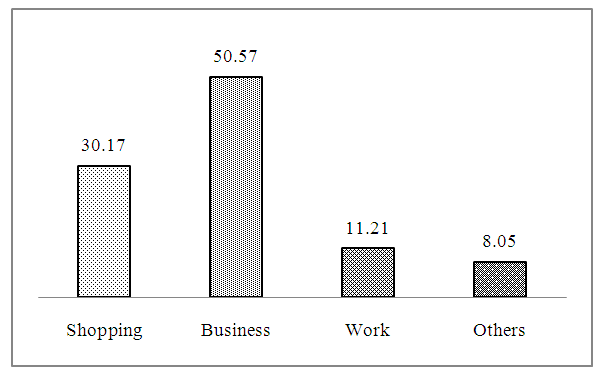 | Figure 1. Trip Purpose to the CBDs (%) |
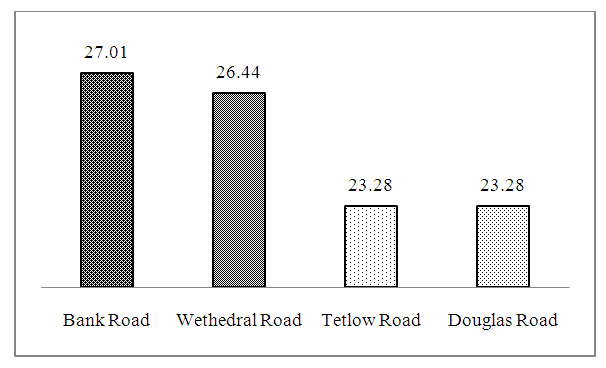 | Figure 2. Commuting Routes to the CBDs (%) |
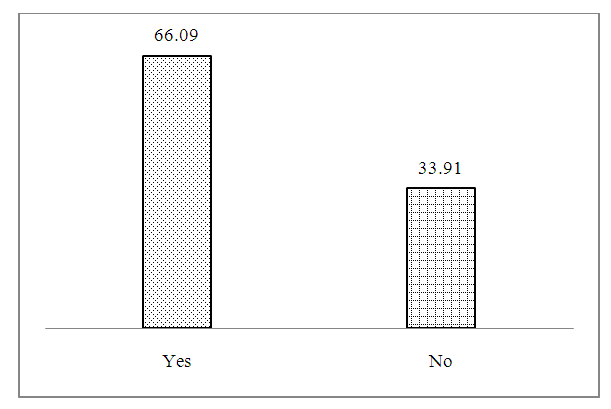 | Figure 3. Driving Status (%) |
|
|
|
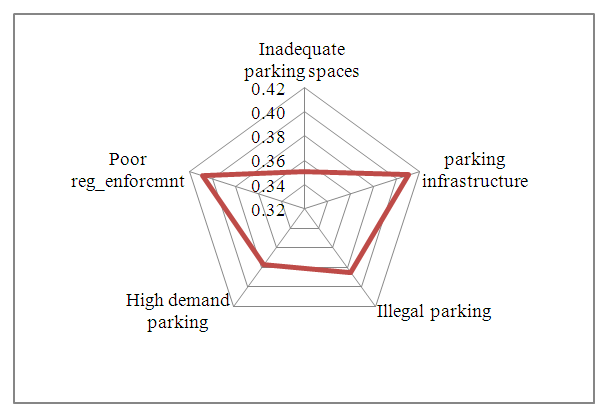 | Figure 4. Opinion on Factors affecting on-street parking in CBDS (proportions) |
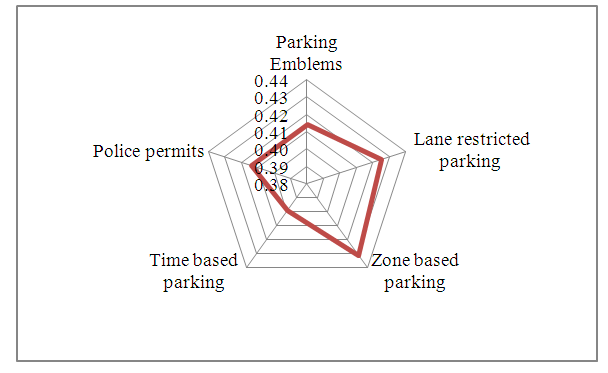 | Figure 5. Opinion on Parking Management Strategies (proportions) |
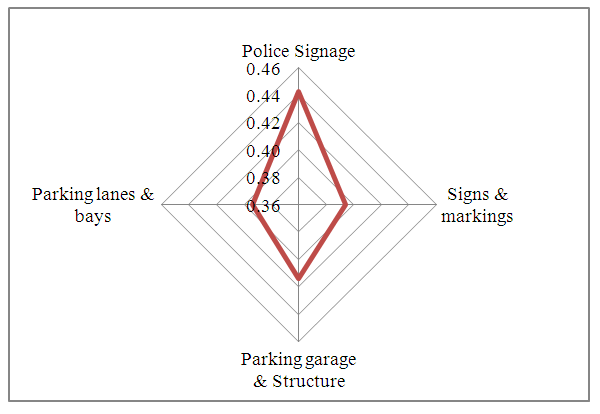 | Figure 6. Opinion on Infrastructure & Facilities for Parking (proportions) |
5. Conclusions
- In conclusion, management of on-street parking in Owerri municipal CBD is a multifaceted challenge that requires careful consideration of various factors and implementation of effective strategies. The research identified several significant factors influencing the current on-street parking situation which include lack of designated parking spaces, insufficient parking infrastructure, illegal parking practices, and weak enforcement of parking regulations. These could contribute to traffic congestion, safety hazards, and urban blight with wider economic implications on the city. Also the challenges associated with managing on-street parking, such as limited physical space for parking facilities and the absence of proper parking regulations, further complicate the situation. Addressing these challenges will require innovative approaches and a collaborative effort from all relevant stakeholders, including city authorities, business owners, city residents, and visitors. The study found significant strategies for managing on-street parking in Owerri CBD. These strategies include the implementation of approved parking signage, time-limited parking zones, parking permits with zone-based restrictions and provision of parking infrastructure. By adopting these practices, the city can achieve more efficient parking management and alleviate the current on-street parking problems.
6. Recommendations
- Taking into consideration the finding of this research, we therefore recommend the following for mitigating the parking problem in Owerri CBD viz:i. Enforcement of parking rules and regulations. Findings suggest that enforcement mechanisms on on-street parking are weak; effective rules and regulations restricting illegal parking are not followed and this has given motorists room to park at any given place. This practice has constituted traffic problems in the area ranging from traffic congestion to blockage of pedestrian pathway. Therefore, administrative approach consistent with Li & Wang [15] needs to be applied through re-invigorating the recognised institutions, taskforces and application of technology to monitor compliance.ii. Public Awareness and Engagement: the relevant authority should educate the general public on the need to maintain a proper parking conduct so as not constitute any problem that would obstruct the flow of traffic and also to prevent endangering the lives pedestrians and other road users.iii. Implementation of zonal parking permits and restrictions consistent with Purcher & Renne [21]. There should be implementation of zonal permits and restrictions whereby every motorists or drivers should obtain a parking permit on the region within the CBD they commute the most. This will enable the authority know the exact numbers of those who use the parking facilities in the CBD and this is necessary for planning purposes.iv. Implementation of pay and display of emblems systems: This process enables road users pay and obtain an emblem in form of a sticker which will give then license to park at a given parking spot. The emblem renewal should be done monthly and with a reasonable fee so to limit the inflow of vehicles into the CBD areas. This may serve as alternative for those who could not get a zonal parking permit.v. There is need to provide parking infrastructure through expansion of road bays (where space permits) and multi-story parking facilities.vi. Smart parking technologies as highlighted by Hatzopoulou [17], Wiseman [30], Zhang et al. [31], Stein [32] and Tang, et al., [33] should be considered as a more sustainable solution given the limited availability of spaces for park development. This option is futuristic since intelligent transport infrastructure and systems are not yet in place in cities of developing countries like Owerri municipality.Future studies should consider research on the requirements for adoption of intelligent transport system (ITS) in urban transport management. ITS infrastructure and facilities are yet to be implemented for traffic management in Nigeria’s capital cities. This is the basic infrastructure required for introduction of Smart parking technologies which is seen globally to offer sustainable solution for on-street parking challenges in CBDs.
 Abstract
Abstract Reference
Reference Full-Text PDF
Full-Text PDF Full-text HTML
Full-text HTML